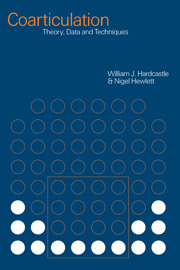Book contents
- Frontmatter
- Contents
- List of figures
- List of tables
- List of contributors
- Acknowledgments
- Introduction
- Part I Theories and models
- Part II Research results: components of the motor system for speech
- Part III Wider perspectives
- Part IV Instrumental techniques
- 10 Palatography
- 11 Imaging techniques
- 12 Electromagnetic articulography
- 13 Electromyography
- 14 Transducers for investigating velopharyngeal function
- 15 Techniques for investigating laryngeal articulation
- 16 Acoustic analysis
- References
- Index
11 - Imaging techniques
Published online by Cambridge University Press: 22 September 2009
- Frontmatter
- Contents
- List of figures
- List of tables
- List of contributors
- Acknowledgments
- Introduction
- Part I Theories and models
- Part II Research results: components of the motor system for speech
- Part III Wider perspectives
- Part IV Instrumental techniques
- 10 Palatography
- 11 Imaging techniques
- 12 Electromagnetic articulography
- 13 Electromyography
- 14 Transducers for investigating velopharyngeal function
- 15 Techniques for investigating laryngeal articulation
- 16 Acoustic analysis
- References
- Index
Summary
Introduction
This chapter is concerned with how imaging systems can be used to answer the questions and address the issues pertinent to coarticulation. At first glance one might be sceptical about the role of systems which are static or limited to video frame rates in answering subtle coarticulatory questions about the interaction of articulators and phonemes in the rapid movements used for speech. On further consideration, however, there are many issues that can be explored via imaging techniques and some questions that can only be answered using such techniques.
The patterns of speech events are well captured by image sequences, like those created using X-ray and ultrasound. Image sequences display important features of articulatory behaviour, which are often difficult to obtain, such as the interaction of several articulators, pharyngeal behaviours, cross-sectional tongue movement and three-dimensional components of tongue behaviour. Point tracking systems have advantages over current imaging systems. Point tracking techniques have a much faster sampling rate than imaging systems and they measure the movement of actual tissue points. However, imaging techniques have advantages over point tracking measures. Imaging techniques provide true two-dimensional (2D) movement data, such as the movement of the entire tongue profile, rather than the one-dimensional movement of a single point or series of points. Images also indicate the true high point of the tongue, not the point of the highest marker.
- Type
- Chapter
- Information
- CoarticulationTheory, Data and Techniques, pp. 246 - 259Publisher: Cambridge University PressPrint publication year: 1999



